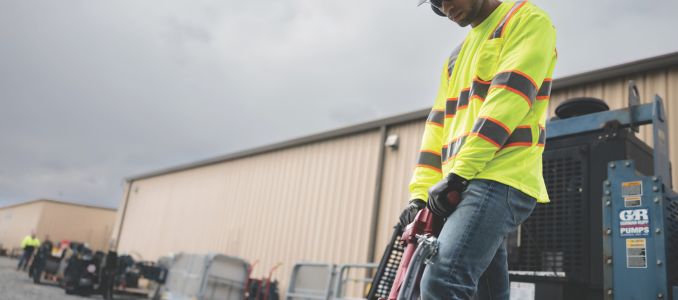
What is Double Hearing Protection and When Would You Need It?
Your solution to extremely loud work environments.
- By Ben Julian
- Jun 30, 2025
You might be asking yourself if double hearing protection is something you should be considering. In order to understand what double hearing protection is, let’s start by reviewing why it is needed.
OSHA has Occupational Noise Exposure standards in the U.S. to protect general industry workers from experiencing hearing damage by regulating the amount of noise they’re exposed to on the job, requiring the implementation of a hearing conservation program and having administrative controls in place. For general industry applications including utility work, manufacturing work and service sector work, adhering to this OSHA standard can typically be achieved by using a single hearing protection device—be it ear muffs or ear plugs. This is because the attenuation of a singular hearing protection device is enough to ensure adequate hearing protection for the wearer. Double protection is necessary when the attenuation of a singular hearing protection device is not enough to ensure adequate hearing protection for the wearer.
Let’s review the conditions where the protection from a single hearing device would be insufficient. According to the National Institute for Occupational Safety and Health, any worker whose 8-hour time-weighted average (TWA) exposure exceeds 100 dBA should wear double hearing protection. Double hearing protection is also required by OSHA in mining operations governed by the Mine Safety & Health Administration (MSHA) for noise exposures in excess of 105 dBA for an 8-hour time-weighted average (TWA).
Cracking The Code on Double Hearing Protection
Now that we have identified a few situations that require the use of double hearing protection, let’s expand on what double hearing protection is. It’s simpler than you think: Double hearing protection occurs when two hearing protection devices are used at the same time.
The dual or “double protection” factor is most commonly achieved by wearing ear plugs under a pair of ear muffs. A key element of ensuring you’re receiving the highest decibel (dB) protection when utilizing ear plugs as a part of your dual hearing protection is understanding the impact their fit has on effectiveness. To receive the highest protection, the ear plug must be worn properly. If not, the added dB from wearing dual protection may not be achieved.
Wondering how double protection translates to a higher dB? All it takes is a simple calculation to determine what dB your double hearing protection is providing: Add 5 dBA to the highest Noise Reduction Rating (NRR) of the higher-rated hearing device. For example, if you are using an ear plug with a 30 NRR and an ear muff with a 26 NRR, you would add 5 dB to the 30 NRR for the ear plug. Your protection level would then increase to 35 dB, assuming the ear plug is worn properly. This simplified method of calculating double protection dBA is based on OSHA recommendations for doubling protection.
Are There Any Disadvantages?
One downside to wearing double protection is that it may put the worker in harm’s way should the worker be unable to hear warning signs in their surrounding area. For this reason, double hearing protection should be carefully considered for certain worksites. Best practice is to use the right product to attain the comfort level and fit you need to be safe on the job without compromising your ability to be aware of your surroundings.
Noise-induced hearing loss is a common workplace injury that is 100% preventable. PIP® offers a complete line of hearing protection products that keep workers protected from loud working environments while achieving all-day comfort and optimal sound attenuation.
The Importance of Proper Hearing Protection Application and Fit
Like previously mentioned, no matter the use of single or double hearing protection devices, proper application of this PPE is essential in preventing occupational hearing loss. Even when high-quality earplugs or earmuffs are provided, they are only effective if worn correctly. Improper insertion or a loose fit can significantly reduce their protective capabilities. When hearing protection is not properly sealed or secured, harmful noise can bypass the barrier and damage the delicate structures of the inner ear over time.
Educating workers on how to correctly use hearing protection ensures they receive the full noise reduction rating (NRR) intended by the device, helping to maintain long-term auditory health and comply with workplace safety regulations such as those set by OSHA and NIOSH. Consistent training and reinforcement of proper usage are key components of an effective hearing conservation program.
When it comes to ear plugs specifically, finding the right fit and shape is critical for effective hearing protection, as ear canals—much like fingerprints—are unique to each individual. Workers have different ear canal sizes, shapes, and sensitivities, which means a one-size-fits-all approach can lead to discomfort, improper fit, and reduced protection. An earplug that is too small may not seal properly, allowing dangerous noise levels to penetrate, while one that is too large can cause discomfort and discourage consistent use.
Offering a variety of earplug styles—such as foam, pre-molded, or custom-molded options—ensures that every worker can find a solution that fits securely and comfortably. When earplugs match the unique contours of a worker’s ear, they are more likely to be worn correctly and consistently, maximizing noise reduction and significantly lowering the risk of occupational hearing damage.
This article originally appeared in the June 2025 issue of Occupational Health & Safety.